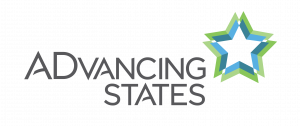Real Choice Systems Change
GEORGIA
Identified Problems with the State's Long-Term Care System
- Nursing facility admissions have increased by 30 percent in the past 5 years and occupancy rates remain relatively high. Institutional placement often conflicts with the wishes of service recipients.
- Relatively few, if any, community service provider options are available in many of Georgia's counties.
- Numerous access barriers include: lack of a uniform intake and evaluation process, delays in eligibility determination; lack of information on choice, and inadequate data for data-based decision making.
- Numerous systems barriers include: (1) Medicaid waiver program inflexibility; (2) inadequate funding in general and the inability for dollars to follow consumers; (3) lack of integrated services; (4) lack of affordable and accessible housing; (5) inadequate workforce development and a shortage of workers; and (6) inefficient and redundant monitoring.
- Lack of communication regarding current initiatives among Georgia's large number of diverse stakeholders results in inadequate collaboration.
- Inadequate and inconsistent emphasis on consumer-directed planning, programs and services. Innovative initiatives are sporadic, target only specific issues, and involve specific disability and advocacy groups, and tend to terminate when their initial funding ends.
Perceived Strengths
- The state has several programs offering "core" home and community services such as service coordination, personal assistance, home health services, emergency response systems, and respite care.
- An Olmstead Planning Committee, established by the Governor, guides the Departments of Human Resources and Community Health in developing a set of recommended action plans for implementation by the state. The committee consists of providers, families, consumers, and advocates.
- The Governor appointed a Blue Ribbon Task Force on Home and Community-Based Services comprising 17 individuals representing consumers, parents, advocates and professionals with a broad range of knowledge and expertise to make recommendations.
- The FY 2002 budget expanded the number of slots in current home and community service programs by over 1,200 and increased provider rates by 4 percent.
- The state is evaluating the feasibility of a Medicaid buy-in for working people with disabilities and the fiscal impact of including personal care services in the Medicaid State Plan.
- The state's efforts to address the need for supported employment have been nationally recognized.
- There is a strong, active consumer empowerment and self-advocacy movement.
- Georgia's Council on Aging recommends legislation, serves on committees and task forces, and provides leadership to the Coalition of Advocates for Georgia's Elderly (CO-AGE). Council members include ten consumers at least 60 years of age, and ten service providers, representing minorities, low-income, rural, urban and public and private organizations.
- Georgia's "Unlock the Waiting Lists" Campaign is a partnership between different long-term care constituency groups. Started by parents and consumers, the Campaign has quickly gained momentum and created public awareness of the need for home and community services.
- A growing Independent Living Network comprises seven local, consumer-controlled non-profit Centers for Independent Living (CIL) and the Statewide Independent Living Council of Georgia.
Primary Focus of Grant Activities
- Address system barriers to community integrated living.
- Improve the quality and availability of the workforce that supports elderly persons and people with disabilities in community-integrated settings.
- Develop an enduring mechanism for consumer involvement in all aspects of the integrated community service delivery system.
- Develop effective communication and collaboration to enhance planning and implementation of integrated community services system changes.
Goals, Objectives, and Activities
Overall Goal. Build state capacity to improve the accessibility and availability of home and community services for elderly people and people with disabilities.
Goal. Address system barriers to community integrated living.
Objectives/Activities
- Develop strategies to recruit, retain and improve the workforce that supports elderly persons and people with disabilities in community-integrated settings.
- Implement a pilot program to develop curricula and provide training for personal assistance workers who provide direct care to people with mental illness and developmental disabilities.
- Evaluate the training pilot and revise curricula as necessary.
- Support the development of a single point of access for people with mental illness and developmental disabilities as specified in HB 498.
- Develop a certification program for administration of medications in specified community residential settings.
- Partner with the Center for Mental Health Services Olmstead Housing Coalition in a housing demonstration project that will transition 50 individuals with severe mental illness from Mental Heath institutions. The RC Grant will fund the training and evaluation components of the project.
Goal. Develop an ongoing mechanism for consumer involvement in all aspects of the integrated community service delivery system for elderly people and people with disabilities.
Objectives/Activities
- Develop training programs for consumers to enhance informed consumer choice regarding the transition from institutional to community services.
- Using the system's current peer support specialists, implement pilot training programs for consumers, evaluate, and revise training curricula as necessary.
Goal. Develop a process for effective communication and collaboration to enhance planning and implementation of integrated community services system changes.
Objectives/Activities
- Review current policies and procedures to make recommendations for improved information sharing and collaborative relationships among state agencies.
- Run focus groups to obtain stakeholders input to make recommendations for improved communications between state agencies and elderly persons, people with disabilities and family members.
Key Activities and Products
- Develop a medication administration certification program for adoption by the Division of Mental Health, Developmental Disabilities and Addictive Diseases.
- Develop strategies that will enhance the ability to recruit, retain, and improve the personal assistance workforce that supports elderly persons and people with disabilities in community-integrated settings.
- Evaluate the effectiveness of supported housing for adults with serious mental illness.
- Develop training programs for peer supporters to enhance transition of individuals from institutions to community-integrated settings.
- Develop and implement actions for improved communication with elderly persons, people with disabilities, and family members and advocates, and to improve communication and coordination among state agencies.
- Support the development of a single point of access for people with mental illness and developmental disabilities.
Consumer Partners
The Stakeholders Group comprises consumers, family, members, representatives of state agencies and advocates.
The Consumer and State Task Force that will oversee this project includes a wide range of stakeholders, including:
- Consumers and their families.
- Statewide consumer disability and aging organizations include the Governor's Council of Developmental Disabilities, Georgia Mental Health Consumer Network, People First of Georgia, Statewide Independent Living Council of Georgia, Disability Link, and the Georgia Council on Aging.
- A representative from each of the two Nursing Facility Transition Grant projects.
Consumer Partners and Consumer Involvement in Planning Activities
The Stakeholders Group, the original planning group, developed the Real Choice Systems Change Grant. They reprioritized the goals of the original grant application, selected key outcomes to indicate success, and added strategies to accomplish each goal.
Consumer Partners and Consumer Involvement in Implementation Activities
The Consumer and State Task Force will play an active role in analysis, planning, implementation, monitoring and evaluation activities. The Task Force will use evaluation results to recommend modifications to the state's existing long-term care system (e.g., strengthening existing programs and/or developing additional ones). Specifically, Task Force members will provide oversight and guidance to accomplish the projects defined in the grant and will serve on work groups for each of the six defined projects.
Public Partners
- Area Agencies on Aging.
- The Department of Community Health (Georgia's Medicaid agency).
- The Department of Labor.
- The Department of Community Affairs.
- Albany Technical College (possible subcontractor).
- Valdosta State University (future subcontractor).
- The University of Georgia (possible subcontractor).
Private Partners and Subcontractors
- Community Friendship.
- Albany ARC.
- Independent Living Centers.
- Janet Rechtman and Associates.
- Ellen Mazer Consultancy.
Public and Private Partnership Development/Involvement in the Planning Phase
Public and private partners were part of the original Stakeholders Group and were involved in the activities described under the section Consumer Involvement in Planning. Staff from the Department of Human Resources and Ellen Mazer Consultancy wrote the grant application.
Public and Private Partnership Development/Involvement in Implementation
Public Partners
As members of the Consumer and State Task Force, public partners will be involved in the activities described under the section Consumer Involvement in Implementation. Specifically, public partners will be participate as follows:
- The Department of Community Affairs is providing affordable housing for the Supported Housing project.
- The Department of Labor will work with local providers to assess consumers for possible employment, train and prepare consumers for employment and assist in job placement.
- Valdosta State University will lead the evaluation of the Supported Housing project.
- Albany Technical College is piloting a personal assistance worker training program that can lead to certification.
Private Partners
- Janet Rechtman and Associates will facilitate the Medication Administration project stakeholders meetings.
- Community Friendship will provide staff to serve on the workforce development project.
- Albany ARC will cooperate with the technical college to run training projects for personal assistance workers and will be involved in the medication certification project.
- Independent Living Centers are members of the Consumer and State Task Force and will participate in work groups for all the grant activities.
Existing Partnerships That Will Be Used to Leverage or Support Project Activities
- The grant will build on existing consumer empowerment initiatives, such as Partners in Policy Making, Peer Centers, Self-Advocacy and Consumer Leadership by developing new curricula for peer support training for people with Developmental Disabilities, mental illness and physical disabilities; by conducting regionally based training; and by investigating the options for peer supports for people who are elderly.
- Coordinate with the Department of Community Affairs (DCA), which will provide DHR with 200 Section 8 vouchers for people with disabilities. Fifty of these vouchers are tied to the Real Choice Systems Change Grant.
- Collaborate with a CMS Olmstead grant to extend supported housing training to personal assistance workers not involved in the Olmstead Housing Coalition planned demonstration project on supported housing. The Olmstead Grant funds will pay for the training while the Real Choice Grant funds will pay for the curriculum development.
Oversight/Advisory Committee
The Consumer and State Task Force, with the active participation of people with various disabilities, will provide the project's oversight and guidance; review the project's evaluation information/data; and document and justify the need for any continuation resources for the project's various initiatives.
Formative Learning and Evaluation Activities
A comprehensive evaluation process will be conducted to increase the effectiveness of the project's management and administration, by identifying the need for modifications to the work plan, documenting that objectives have been met, and determining the overall effectiveness of the project.
Evidence of Enduring Change/Sustainability
- The state will have the capacity to generate data reports critical to long-term care service planning.
- Intake and evaluation procedures will be standardized.
- Information on available resources and services will be maintained by the Department of Human Resources.
- A formalized peer support process for consumer information and guidance will support consumer choice-making.
- The continuation of the Consumer System Change Network (that began with the starter grant) will provide real world information from people who rely on long-term support services.
- The development of an infrastructure for effective communication and collaboration on system changes among consumers, state agencies and other stakeholders will ensure continuous quality improvement of the long-term care services system.
- The establishment of a Consumer and State Task Force may create an ongoing process to address barriers to community-integrated living, although given the current economic crisis, it is impossible to predict if the Task Force will continue or what processes will be in place.
- The establishment of a training and certification program for medication administration.
- The establishment of training programs in area technical colleges for personal assistance workers.
Geographic Focus
Rural and urban areas in seven regions of the state.

